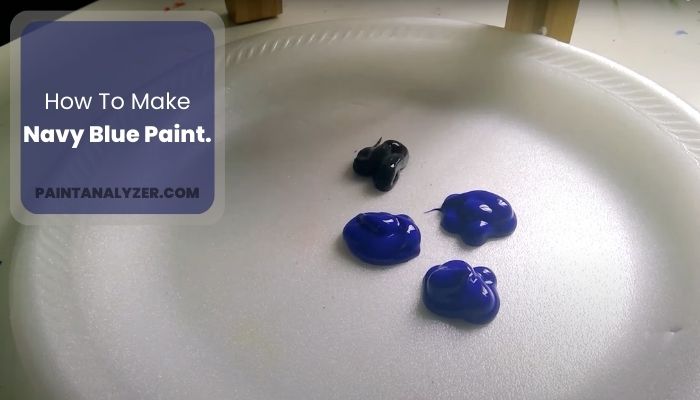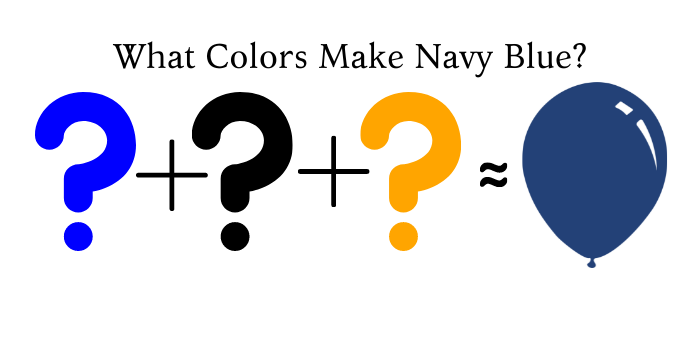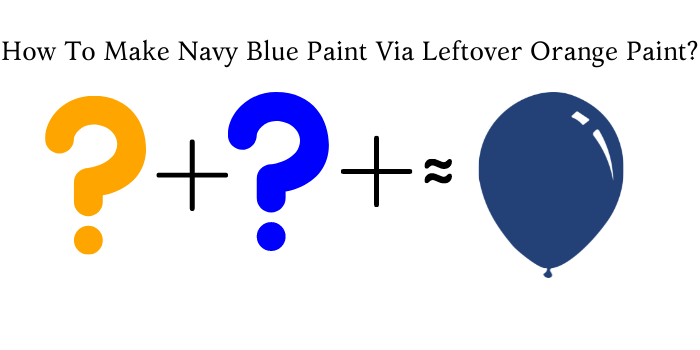While painting, you can’t always have all the colors. In such cases, you’ll have no choice but to mix and match two or more colors to create that missing color. Following that condition, do you know how to make navy blue paint?
Navy blue is practically a much darker shade of the primary blue. As such, mixing any particularly dark color or paint with blue will result in a hue close to navy blue. You can use orange, purple, ultramarine, or even black to make up navy blue paint by yourself.
In today’s article, we’ll go over the basics of making navy blue paint. Additionally, we’ll provide a sneak peek of the color wheel – the mastermind behind all the color combinations out there.

Color Psychology: Navy Blue
Color psychology deals with the significance of using different colors in life. For instance – lighter colors often represent the joyous occasions in life while the darker ones represent moderately gloomy vibes.
Again, depending on the hue, different colors can represent many different things. Regular lovely red is the symbol of everything related to love and similar feelings. Similarly, the same color in the blood-red shade can mean destruction from a dystopian point of view.
The color psychology of navy blue is no different either. Since it’s a much darker hue, navy blue is often used to represent integrity. Navy blue is also the color of the mighty deep ocean, especially during the moonlit night.
As such, it’s often used to dignify the sea and sailor culture. You’ll find many naval base troops using navy blue in their ships and flags. Navy blue is also closely related to royal blue. Even now, you’ll see members of the royal family dressed in deep velvet navy blue clothes to assert their dominance occasionally.
It’s a color that showcases royalty and the subsequent richness in taste, like nothing else. Navy blue symbolizes power, passion & integrity. It also adds a mysterious tone to the subject sporting this color.
It evokes both ocean-like freedom and independence while subsequently reminiscing the dangers hidden underneath the dark surface.
Primary, Secondary & Tertiary Colors
The concept of primary, secondary, and tertiary colors comes from color theory. It helps to determine which colors will go with each other to make an appealing hue as a by-product.
Primary Colors
There are three primary colors in total. It’s possible to practically derive all other colors from just these three alone.
The primary colors are red, blue, and yellow.
Secondary Colors
When you use any two of the primary colors to make a different color, the result is termed a secondary color. The number of secondary colors is also three, the same as primary colors.
They’re green, orange and purple respectively. Blue and yellow make green, red and yellow make orange, and red and blue make purple.
Tertiary Colors
Tertiary colors are produced when you mix primary colors with secondary colors to come up with a unique and appealing hue.
As such, there are six main tertiary colors as they fit the conditions just right. They’re –
- Red-Orange
- Red-Violet
- Blue-Violet
- Blue-Green
- Yellow-Green
- Yellow-Orange
What Colors Make Navy Blue?

Pure blue, black and orange – these three colors are the prominent ones in making navy blue.
As you can deduce already, navy blue is neither a primary nor a secondary color. In fact, it’s the combination of tertiary colors with primary or secondary colors if you’re using black paint.
Other than these, depending on how light or dark of a navy blue you want, you can use different colors. White & yellow is often used in the preparation of navy blue for lightening it.
Related: What Colors Make Beige
The Measurement Method: Important Tips
To know how to make navy blue paint, you must first have a firm grasp of the measurement method. Otherwise, you’ll just keep adding colors in inappropriate ratios without ever achieving the desired results.
Here are a few important tips to get your measurement method right:
- Use paint of the same quality to prevent potential distortion in pigmentation afterward
- If you’re using unadulterated hues, use the lighter and darker paint in a 3:1 ratio mostly
- With previously adulterated paint, leave room for errors and mix as you go
- Mix a small amount of paint first before you move on to a much larger batch
- Test the intensity of the color on top of a white paper i.e. light background always
Color Mixing & Matching: Handy Accessories
Here’s a brief overview of all the accessories you’ll possibly need while prepping navy blue:
- Sturdy Paintbrush
- White & Transparent Paper
- Primary Blue Paint
- Pure Black Paint
- Secondary Orange Paint
- Ceramic Paint Mixing Bowl
- Glass Or, Wooden Stick
- Navy Blue Paint Chip
- Airtight Storage Container
How To Make Navy Blue Paint?
Here’s the step-by-step guide on making navy blue the usual way, i.e. by utilizing black and primary blue paint.
Step 1: Prep The Working Area
Paint doesn’t easily wash off from desks or walls most of the time. So, before starting, prepare the working area appropriately by covering the table with a plastic tablecloth.
You can also cover important stuff nearby if you’re worried about paint flecks splitting off. Neatly arrange all the paint tubes, ceramic bowl, white palette, stirring stick, etc.
Step 2: Squeeze Out Both Samples
Put out a small amount of blue from the primary blue paint tube in the bowl. Or the white palette, whichever one you prefer.
Squeeze out black paint beside the blue one, but do not mix them just yet. Don’t put too much black paint out either, since you won’t need it.
Step 3: Mix & Match
Now use the stirring stick to mix just a smidge of black paint with all of the blues. You’ll see that the color has darkened considerably and now is close to the navy blue hue.
Remember to take not too much black paint at a time since it can easily overpower the mix. If you want an even darker shade of navy blue, keep mixing black, but only a smidge at a time.
And there you have it. After mixing both samples thoroughly, you have now managed to prepare the prettiest navy blue paint.
How To Mix Navy Blue Acrylic Paint?
The procedure of mixing navy blue acrylic paint is not that different from regular paint. The only difference is that acrylic paint is not as washable as some of the water-based paint.
Furthermore, acrylics can dry up fast under circulating air, and then it becomes plastic-y. Hence, it’s best to mix acrylic paint in a white ceramic bowl. That way you can later use acetone or denatured alcohol to wash it off.
Remember that acrylics will darken up after drying. If you use too much black, the paint will look dark black than navy blue once it dries up in a while. So, make sure to avoid that.
How To Make Navy Blue Paint Via Leftover Orange Paint?

Black and blue isn’t the only way to get navy blue paint. According to the complementary color wheel, orange directly contrasts with a darker hue of primary blue. As such, you can use leftover orange paint to prepare navy blue.
And the procedure is similar to the aforementioned one as well. The only difference, in this case, is that – you’ll use secondary orange paint instead of true black.
Treat orange just like black in this process. Keep adding only a pint of orange paint into the entirety of blue paint till you reach navy blue. Adding too much orange will make the color seem more orange-y instead. In that case, you’ll have to add some more blue to cancel that out.
What Colors Make Prussian Blue?
Prussian blue is a much darker shade of navy blue. Navy blue has a specific dark blue tone of its own that’s neither black nor blue. Prussian blue, on the other hand, is much closer to black.
Thus, it’s evident that the same colors make both Prussian blue and navy blue. Except that, while making Prussian blue, you’ll need to use more black paint than you did for navy blue. You’ll still need to make sure the black paint doesn’t overpower the overall color.
How To Make Navy Blue Paint From Prussian Blue Paint?
To make navy blue paint from Prussian blue paint, follow these steps:
- Mix Prussian blue with primary blue in a white background palette in a 3:1 ratio preferably
- Mix them properly for a while
- Add and keep adding white paint little by little until you get the desired navy blue paint
Making Navy Blue Paint: Precautions
Check out two of the most prominent precautions about making navy blue paint that everyone seems to forget always!
Use Same Type Of Paint
While mixing two different colors, never attempt to use different types of paint. If you’re using water-based paint, use another water-based paint with it.
Similarly, if you’re using acrylics, i.e. alkyd-based paint, stick with that accordingly. Just like oil and water never mingle, different types of paint don’t mix well either.
Use Proper Gloves
If you’re using water-based paint, you can easily wash it off later with water.
But if you’re using acrylics and the paint dries up, it’ll take much more effort to get rid of it. As such, it’s best to use proper gloves while working with alkyd-based paint.
You can also keep baby oil or denatured alcohol nearby if acrylics do get on the skin. Don’t get impatient if it’s hard. Rub softly in a circular motion to loosen the alkyd bond and get it off.
Read also: Does painting a porch ceiling blue keep wasps away
Frequently Asked Questions
What’s the complementary color wheel?
The complementary color wheel is well, a wheel or a pie chart with all the basic colors. The wheel contains 12 color shades in total, four each for the three primary colors.
The twelve color combinations are arranged in a way that two diagonally opposite colors complement each other. By doing so, the color wheel effectively represents the color theory.
What are the primary colors?
There are three primary colors in total. They’re red, yellow and blue. You can obtain all other color hues from the combination of these three.
Is blue a primary color?
Yes, blue is one of the primary colors. You can obtain most other hues by combining blue with another color. But it’s not possible to mix two, or more secondary colors to make primary blue.
How can I make green from blue paint?
For regular green, you can simply use some yellow with blue paint to make green paint. Depending on how dark or light you want it, you have to adjust the amount of yellow paint.
For navy blue paint, should I use the same amount of black and dark blue paint?
No. Using black and dark blue in a fifty-fifty ratio will result in a much darker shade.
You’ll then obtain Prussian or gaussian blue instead of navy blue paint. For navy blue, you can get by only with a smidge of black paint.
How can I lighten the color if it’s too dark?
Use light colors in appropriate amounts to lighten the color if it ends up too dark. For instance – if your navy blue seems too close to Prussian blue instead, add in a smidge of white.
It’ll soon enough make the paint a lot lighter. Depending on the situation, you can use extremely pale yellow instead of white paint.
Final Word
So, how to make navy blue paint for when you need a much darker and serene shade of blue? Regular blue is pretty, no doubt. But sometimes only a rich navy blue shade can add that much-needed depth and integrity to a paint job.
Today we went over at least three different methods of preparing navy blue paint at home. Make sure to follow all the steps thoroughly for a perfect result. And as always, don’t forget to cover up properly before dealing with acrylics. Having them peel off the skin is NOT a sensation you want to willingly experience.